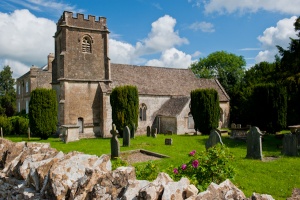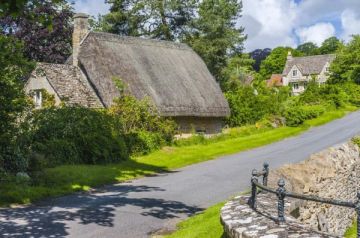
TO SEE
- Saxon carved panels
- Green Man carving on the 15th-century font
- Saxon doorways
- Saxon sundial
The area of the Duntisbourne valley, north of Cirencester, is home to several fascinating historic churches, many with their roots in the Saxon period. Holy Rood in the small village of Daglingworth is one of the most interesting and attractive of these churches, certainly among the most compelling historic churches in Gloucestershire.
There are only 22 churches dedicated to the Holy Rood in England. This is one, and certainly one of the most historically interesting country churches in the south-west.
The first church at Daglingworth was erected in the late Saxon period. That first building was quite simple, consisting of only a nave and chancel, built with traditional Saxon 'long-and-short' quoins at the corners. This type of construction is typical of Saxon work, with alternating courses of horizontal and vertical cornerstones.
To this simple layout, a sturdy west tower was added in the 15th century, and a porch added to the south side. Like so many churches in this area, Holy Rood was rebuilt in the mid-19th century, when the vestry and north aisle were added by Canon Barker.

Immediately west of the porch is the only remaining Saxon window, which was blocked when a larger window beside it was inserted in the 14th century. An even more fascinating window is harder to find; half-hidden by the oil tank is a small window to the vestry.
This is a reused Roman altar stone, bearing an inscription in Latin. Also outside the church is a medieval cross base and shaft, now missing its head. Near the cross are several interesting 17th and 18th-century gravestones, probably carved by the same family of masons.
The porch hides a relatively rare Saxon sundial, which is still visible above the doorway. The sundial is an extremely simple design, with a central hole for a gnomon (the part of a sundial that casts a shadow). The outer arch of the porch is a Saxon arch, probably used as the original west door, but moved here when the porch and tower were added.
Immediately inside the door is the font, a nicely carved 15th-century example. One fascinating feature that you can't see at first glance is a small Green Man carving under the overhang of the font bowl.
THE SAXON CARVINGS
To the left (west) of the door is one of three large 10th century Saxon carvings that are the major attraction of Holy Rood church. At first glance, I actually thought the carving was a modern one by a local craftsman, perhaps carved to celebrate the Millennium. Not so, it is over 1000 years old.
The remarkable state of preservation of the carving is because they were reused for many years as jambs in the chancel arch, with the carved sides facing into the walls. It was only when the Saxon arch was being restored in 1850 that the exquisite carvings came to light. We are so used to seeing Saxon work today in a worn state, so it is a bit of a shock to realise just how the carvings would have looked when they were first created!

Why were they built into the chancel arch, and why were the carvings hidden from view? Was it to hide them from sight? To preserve them? We simply do not know. It is possible that they were simply not valued enough to be thought worthy of preservation. Because the carvings faced inwards into the wall, they have all lost their toes!
The three large Saxon panels (there is a fourth smaller one which we'll come to in a moment) depict the Crucifixion, Christ in majesty, and St Peter bearing the keys to Heaven.
One fascinating feature of the Crucifixion scene is that the Saxons did not like to portray Christ suffering. Even when he is shown on the cross, they depict him as a crowned king. The Crucifixion scene shows this; the crowned figure of Christ is huge compared to the nearby Roman centurion with spear and scourge, and a soldier bearing a container of vinegar and sponge on a reed.
The carved panels of St Peter and Christ in Majesty are set on the wall of the north aisle. The figure of Christ in Majesty shows Jesus seated on a chair, with a beard and moustache. He is giving a blessing with his right hand and carries a cross in his left hand. The figure of St Peter is standing upright, carrying a book in his left hand and a large key in his right. The three large panels were probably the work of a single artist.
The fourth, small Saxon carving is set immediately behind the pulpit. This is much more worn and again shows the Crucifixion. The carving used to decorate the east gable but it was brought inside the church to preserve it from wear.

There is old stained glass in the west window, under the tower. There you can make out the feather symbol of the Prince of Wales, probably a reference to Prince Henry (later Henry V) or Prince Arthur, Henry VIII's elder brother, who died in 1502 before he could take the throne.
By the altar, set into the north wall of the sanctuary, is an intriguing stone credence table. This was formerly an altar, or mensa stone, in a loft over the west part of the nave, used by a priest who may have dwelt in the loft.
VISITING DAGLINGWORTH
The church is at the end of a lane off the minor road that runs north towards the Duntisbournes. Indeed, I suggest combining a visit to Daglingworth with a trip to the fascinating Saxon church at Duntisbourne Rouse, a few miles north. There is a small parking area outside Holy Rood church, across the lane, and the church is normally open during daylight hours.
About Daglingworth
Address: Daglingworth,
Cotswolds,
Gloucestershire,
England, GL7 7AQ
Attraction Type: Historic Church
Location: On a minor road off Overley Road. Parking area beside the church, which is usually open daylight hours.
Location
map
OS: SO994050
Photo Credit: David Ross and Britain Express
HERITAGE
 We've 'tagged' this attraction information to help you find related historic attractions and learn more about major time periods mentioned.
We've 'tagged' this attraction information to help you find related historic attractions and learn more about major time periods mentioned.
Historic Time Periods:
Find other attractions tagged with:
10th century (Time Period) - 15th century (Time Period) - Roman (Time Period) - Saxon (Time Period) -
NEARBY HISTORIC ATTRACTIONS
Heritage Rated from 1- 5 (low to exceptional) on historic interest
Duntisbourne Rouse, St Michael's Church - 0.9 miles (Historic Church) ![]()
Bagendon, St Margaret's Church - 1.5 miles (Historic Church) ![]()
Baunton, St Mary Magdalene Church - 1.8 miles (Historic Church) ![]()
Cerney House Gardens - 2.3 miles (Garden) ![]()
Duntisbourne Abbots, St Peter's Church - 2.3 miles (Historic Church) ![]()
Cirencester Park - 2.3 miles (Garden) ![]()
Cirencester Norman Arch - 2.4 miles (Historic Building) ![]()
Corinium Museum - 2.5 miles (Museum) ![]()
Nearest Holiday Cottages to Daglingworth:
Duntisbourne Abbots, Gloucestershire
Sleeps: 4
Stay from: £875.00 - 2788.00
North Cerney, Gloucestershire
Sleeps: 4
Stay from: £402.00
Cirencester, Gloucestershire
Sleeps: 6
Stay from: £502.00 - 3182.00
More self catering near Daglingworth















